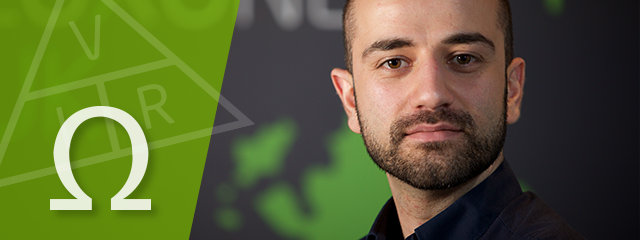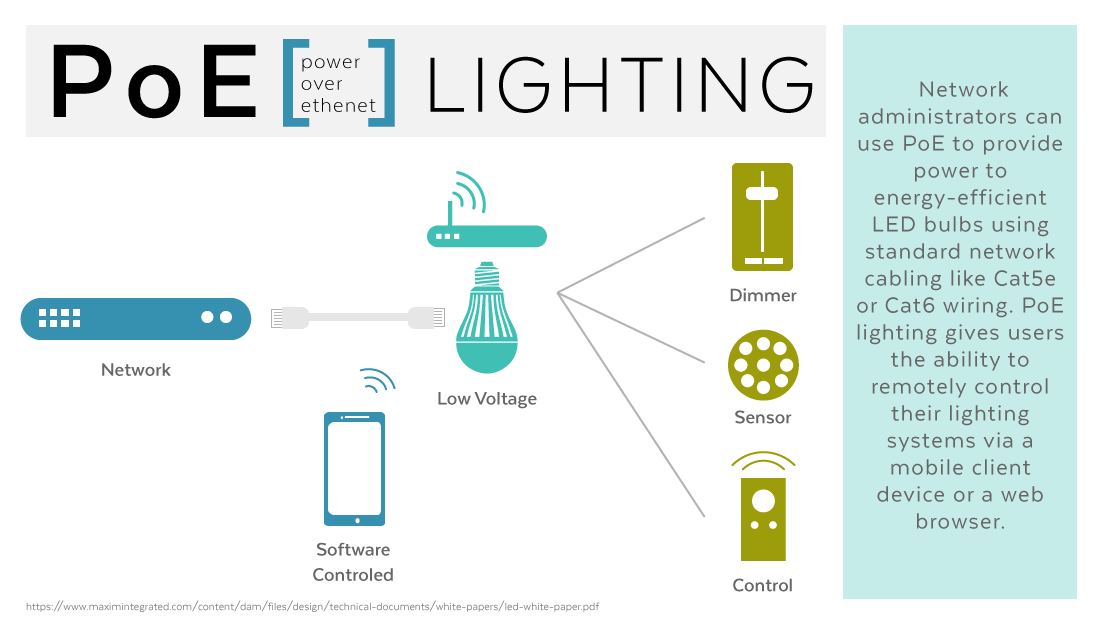
Omid’s Law: A Look At PoE Lighting and Loxone Tree
We are all becoming increasingly comfortable with, and welcome the concept of, a single cable powering a device whilst also providing network connectivity. As such, the term PoE is now commonplace, and likely prompts thoughts of security cameras or wireless access points.
Now that PoE has reached a level of maturity as a technology and standard, let’s take a closer look at one its more novel applications, PoE Lighting.
Let’s walk before we run, though, and take a look at what PoE is.
What is PoE?
In essence, PoE (Power over Ethernet) is the use of one Ethernet cable providing data and power to a device. This generalist approach of using one cable for multiple functions across multiple manufacturers requires structure and guidelines, for which standards have been developed into its current form known as PoE+ (IEEE 802.3at), superseding regular PoE (IEEE 802.3af). The rest of this post will ignore vendor specific incarnations of these, such as the Cisco UPOE standard.
The change from PoE to PoE+ has been prompted by increasingly power hungry PoE devices and the lure of new opportunities that more power will open up.
What does this have to do with lighting?
LED technology is still progressing, continuing to become more cost effective and energy efficient overall. It is this reduction in power requirements that has enabled PoE lighting to become possible, with the average circuit power requirements being well within that of a compliant PoE port.
In addition, the growth of consumer PoE devices (WAPs, IP Cameras et al) has brought the cost of PoE switches down, providing additional possibilities in the lighting arena.
We are now at a stage where PoE is not only technologically possible but a viable alternative to traditional mains voltage lighting.

What are the advantages of PoE lighting?
DC power is preferred across all electronics, for its efficiency, safety, and characteristics which make it hardware friendly. This is why every gadget or device you may have purchased comes with its own plastic brick, to step down your AC voltage from your wall socket down to a device friendly DC voltage.
DC powered devices are categorised as SELV (Separated Extra Low Voltage), defining it as broadly safer than AC devices.
LEDs also use DC voltage, and natively controlling the DC supply to the DC circuit provides many benefits, the most desirable of which is dimming control. With a DC supply, both the dimming range and performance is greatly improved, whilst maintaining optimal energy efficiency.
PoE lighting takes advantage of this DC goodness, and provides top quality lighting that surpasses anything you can get from B&Q; individually addressable fittings, RJ45 terminations, native DC to complement home battery storage, integration of additional sensors, and reduced installation time.
Quick PoE tech specs
The change from powering devices over Twin & Earth cables to thin data cables requires some additional guidance to ensure safety and integrity of the data cable now being used for power.
For this, PoE+ (IEEE 802.3at) defines some strict criteria to keep in mind:
Cable: Minimum CAT5E
Voltage: 42.5vdc – 57vdc
Current: max 600mA load
Powered Device (PD): 25.5w
Power Sourcing Equipment (PSE): 30w per port
Max Length: 100m from port
There are standards due to be passed to define an even higher output PoE, using all 4 pairs of a CAT cable.
Keep an eye out for 4PPoE (IEEE 802.3bt), which looks like it will be pushing out a whopping 100W down a single CAT cable.
What are the drawbacks of PoE lighting?
There are a few compromises when opting for PoE Lighting, the most significant being the limited range of fittings, and the final cost per circuit.
With the number of PoE Lighting manufacturers still being low, you are limited to a handful of manufacturers. This currently low volume market means prices are still generally high, and product ranges small. Expect this to change in time, as economies of scale will allow expanded ranges at lower prices in the future.
There are also additional costs in the other essential items to get this operational, consider the cost of a suitable PoE switch, alongside a control or automation system to manage the operation of the lighting, and the price will quickly rise. Let’s not forget the extra cable and termination costs involved with star wiring every single fitting!
For all its efficiencies and benefits, there’s no escaping the fact that the final cost per circuit is still high when compared to basic, traditional AC lighting installations.
Is Loxone Tree the same as PoE lighting?
No. Loxone Tree is a technology as well as a wiring topology. Loxone Tree was designed as an alternative to star wiring to offer a quicker installation time with fewer cables.
Tree was developed for the smart home as a whole, and not just for lighting. Nevertheless, you can achieve some great features by automating lighting using Loxone Tree.
As with PoE, Loxone Tree allows you to communicate and power devices via a single CAT cable and with the RGBW Dimmer Tree and our range of Tree spots can just like PoE be used for lighting control. There are, however, a few key differences between PoE and Loxone Tree.
For instance, You don’t have to star wire! Loxone Tree is a free form topology allowing you to reduce the amount of wiring whilst still being able to address every single device. It also does not force you to use RJ45 terminals, which can be rather fiddly. Additionally, you can use a separate cable for supplying power to devices, hence removing any power limitations that PoE may have.
Coming back to lighting – of course, like PoE, Tree fittings are slightly more expensive than traditional spots, but those looking for more advanced control may well find the investment is worth it as part of their smart home installation.
Tree Spots are individually addressable, just like PoE. In an office setting, this is good for efficiency, since leaving office lights and desktops on constantly is pretty much a British pastime. You could also just use addressable Tree drivers, and put any 24VDC light fitting on the end of it, giving you further aesthetic choice for your lights.
In the home, however, Loxone Tree can offer features which sit more towards the lighting design side of things. Those with open plan homes may find that having individually addressable spotlights is ideal for zoning areas within the home. Likewise, if the room is rearranged and furniture is moved around within the space, Tree lights will be able to adapt to this.
Conclusion
Is this the end of lighting as we know it? Well, maybe not quite. Certainly, PoE lighting is likely to become more commonplace, however, it looks set for wider adoption in the commercial space before it starts to become a standard for our homes. There’s still a long way to go when it comes to consumer awareness about smart home technology as a whole, so for now, we’ll have to wait and see how this develops.
